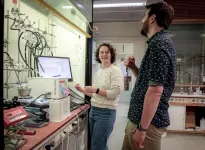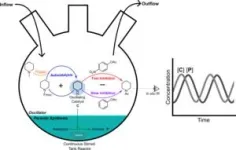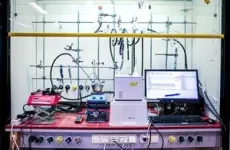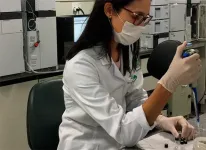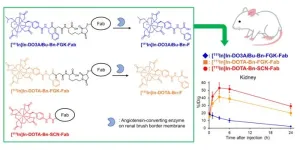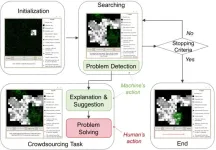(Press-News.org) Oscillating chemical systems are present at nearly every popular chemistry exhibition – especially the ones that display striking colour changes. But so far there are very few practical uses for these types of reactions beyond timekeeping. In nature, on the other hand, many important life processes such as cell division and circadian rhythms involve oscillations. Scientists at the University of Groningen have now developed an oscillating system that contains a catalyst, and exhibits periodic catalytic activity: this synthetic chemical oscillator can do more than just keep time. A description of this complex behaviour created from simple molecules was published in Nature on 6 September.
The conventional way to perform complex chemical reactions is a step-by-step process of single reactions, with purifications between the steps. The system devised in the lab of University of Groningen Professor of Homogeneous Catalysis Syuzanna Harutyunyan takes an entirely different approach, more similar to what happens in living cells. Different components are mixed together in a flow cell where all reactions take place at the same time. ‘By combining positive and negative feedback loops, we made all reactions work together to produce an oscillating system’, explains Matthijs ter Harmsel, a former PhD student in the Harutyunyan group. The inflow of fresh chemicals is regulated in such a way that the system remains out of equilibrium.
Trigger
Ter Harmsel designed a system consisting of five different chemical reactions all occurring in the same flask where each chemical component has its unique purpose. At its core is piperidine, combined with a fluorenyl methoxycarbonyl protecting group (Fmoc). This base-labile protecting group is widely used in organic synthesis. A trigger molecule removes the protecting group and the resulting piperidine acts as a catalyst for its own formation. Two different acetates act as inhibitors, one fast, and one slow. The slow inhibitor irreversibly removes the piperidine from the mixture.
The entire process takes place inside a continuously stirred tank reactor with an inflow of reagents and an outflow of reaction products. ‘By combining positive and negative feedback loops, we produced a pulse, the single component of an oscillating system’, explains Ter Harmsel. ‘Next, I used a model that contains the speed for all chemical reactions inside the reactor, which allowed me to determine at which concentrations the system would oscillate’.
Two years
With some help from Oliver Maguire from the Huck lab at the Radboud University Nijmegen, the right conditions for the oscillating system were found. Together with Ter Harmsel, Maguire successfully implemented the oscillating reaction network in a flow reactor, allowing the system to reach the oscillatory phase.
As the key oscillating species is a small molecule organocatalyst, the researchers reasoned that by having it accelerate separate chemical reactions they can be made to oscillate as well. This, in turn, leads to enhanced chemical selectivity in coupled systems, favoring one reaction over the other in a mixture of reactions.
As a result of the oscillations, the amount of the chemicals, including piperidine organocatalyst, increases and decreases regularly. ‘It took us two years to create the system, which contains a network of thirteen different components’, says Syuzanna Harutyunyan. ‘Once we had a first pulse in the formation of our organocatalyst, we knew we could make it oscillate.’ Wilhelm Huck: ‘This was a very exciting multidisciplinary collaboration, where synthetic chemistry, catalysis, physical organic chemistry, and theory, all contributed to make a chemical system “tick”.’
Polymer brushes
The new oscillator is not designed for nice colour changes, but to do real work, such as autonomous time-controlled periodic synthesis. Biologists wouldn’t be surprised by this, as many biological systems show oscillations with coupled processes. Ter Harmsel: ‘However, to organic chemists or those working in catalysis, it is a strange concept.’ Ter Harmsel is interested in systems chemistry, an area that is more like biology.
The oscillating system might also have practical applications, and could for example be used to synthesize polymers, explains Sofiya Runikhina, a postdoc in the group: ‘We are working on that right now. We want to add beads to the reactor on which polymers can grow. At each oscillation, monomers are added to the growing chain. This is a very neat way to grow dense polymer brushes.’
Possibilities
Other applications, Ter Harmsel adds, could be in drug delivery. ‘Lots of drugs have structures resembling piperidine. Some hormones might act as triggers, like the ones we use to start the oscillations.’ Also, the system could be used as a filter, in which unwanted products react fast and disappear, while the desired molecule does not have time to react during the short bursts when the catalyst is present and will therefore be present in the efflux of the reactor.
‘We have demonstrated that it is possible to create a complex system that combines oscillations and catalysis with very simple molecules, that are present in almost any organic chemistry lab’, concludes Harutyunyan. This opens up all kinds of possibilities. ‘A system like this has never been described, so we anticipate many new developments. There may be potential applications that we haven’t even thought about yet.’
Reference: Matthijs ter Harmsel, Oliver R. Maguire, Sofiya A. Runikhina, Albert S. Y. Wong, Wilhelm T. S. Huck, Syuzanna R. Harutyunyan: A catalytically active oscillator made from small organic molecules. Nature, 6 September 2023
An animation explaining the oscillating system will be available after the embargo expires.
END
The first organic oscillator that makes catalysis swing
2023-09-06
ELSE PRESS RELEASES FROM THIS DATE:
Scripps Research chemists devise a method for C-H activation of alcohols
2023-09-06
LA JOLLA, CA—Scripps Research chemists have extended a powerful molecule-building method—called C-H activation—to the broad class of chemicals known as alcohols.
The synthetic chemistry feat, reported in Nature on September 6, 2023, follows the development of C-H activation techniques for the three other major classes of organic molecule—amines, acids and ketones—that are used to construct pharmaceuticals. It gives chemists a versatile new toolkit for making drugs and other valuable compounds now using the alcohol chemical class; moreover, its ...
Pitt researchers to study Alzheimer’s disease in marmosets
2023-09-06
PITTSBURGH – To reimagine existing preclinical trials for Alzheimer’s disease, University of Pittsburgh School of Medicine neuroscientists created the first non-human primate model of hereditary Alzheimer's in marmoset monkeys, outlining their approach in Alzheimer's & Dementia: Translational Research & Clinical Interventions.
Researchers are now working on characterizing and validating genetic, molecular, functional and cognitive features of aging and Alzheimer’s disease in marmosets that harbor mutations in the same gene that is linked to early-onset disease in humans. Scientists hope to accelerate the pace of the ...
Oral health deteriorates before and after bariatric surgery, study shows
2023-09-06
Oral health deteriorates in morbidly obese people on a diet in preparation for bariatric surgery and patients who have undergone the procedure, with increasing caries, gingivitis and periodontitis. This is the conclusion of a study conducted by researchers at the Federal University of São Paulo (UNIFESP) in Brazil. Articles on the study are published in the Journal of Oral Rehabilitation and Clinical Oral Investigations, stressing the importance of participation by a dentist in the assessment of bariatric patients.
The study was funded by FAPESP (projects 17/26400-6 and 16/10940-9), following 100 patients divided into two groups (dietary ...
Patients with AML who received vitamin C/D supplements had fewer complications, but no overall survival benefit seen
2023-09-06
Patients with acute myeloid leukemia (AML) who received vitamin C and D supplements while undergoing intensive chemotherapy had lower rates of complications, such as infections, bleeding, and inflammation, when compared with similar, previously treated patients who did not receive these supplements. Moreover, while the study showed no difference in survival between the two groups, a subgroup analysis showed that among patients with a genetic mutation known as NPM1 – found in about one in three patients with AML – the risk of death was nearly 50% lower among those ...
University of Colorado ophthalmologists administer novel treatment for single patient facing rare genetic condition
2023-09-06
Thirteen-year-old Grace Hoyt received potentially the best birthday gift ever this month when pediatric ophthalmologists at the University of Colorado School of Medicine and Children’s Hospital Colorado administered the first treatment designed specifically to slow her vision loss associated with posterior column ataxia with retinitis pigmentosa (PCARP), a rare genetic condition that affects vision and the nervous system.
“It’s so incredible that she has this opportunity,” Susan Hoyt says of her daughter, who received the first treatment Aug. 24. “We’ve known that Grace is going to go blind, but to have ...
Novel molecular design for enhanced efficacy and safety in radiotheranostics
2023-09-06
Radiotheranostics embodies the convergence of diagnostic and therapeutic radiopharmaceuticals into a unified platform. In cancer treatment, radiotheranostic procedures typically involve the use of antibodies that bind to proteins abundantly found on the surface of cancerous cells. The antibodies are labeled with a suitable radioisotope, which facilitates imaging procedures used to diagnose cancer and can be used to target cancerous cells and bombard them with deadly radiation as a form of treatment.
Although radiolabeled antibodies show promise as a treatment for cancer, several hurdles impede their clinical translation. ...
Potential target for reversing drug resistance in ovarian cancer identified
2023-09-06
For the 314,000 people diagnosed with ovarian cancer each year, hope often comes in the form of platinum-based drugs such as cisplatin.
Cisplatin causes the death of quick-dividing tumour cells, so it is a potent first-line defence in the treatment of the often fatal disease.
However, over half of ovarian cancer patients develop recurrence and become resistant to cisplatin and other platinum-based chemotherapies, contributing to the five-year survival rate of 31%.
It is unclear why this resistance occurs, but a solution is urgently ...
Human-AI collaboration improves source search outcomes
2023-09-06
When artificial intelligence robots that have been designed to use algorithms to complete source search tasks, such as search and rescue operations during a fire, encounter a disturbance, they are often unable to complete their task. Proposed solutions have ranged from trying to improve algorithms to introducing additional robots, but these AI-driven robots still encounter fatal problems.
Researchers have proposed a solution: a human-AI collaboration that takes advantages of the unique skills of the human brain to overcome challenges.
The paper was published in the Journal of Social ...
Teleneurology challenges met by training curriculum
2023-09-06
A new physician-training system in telehealth simulates key parts of traditional, in-person neurological exams that use little reflex hammers, pinpricks, and flashlights to test nerve function. The three-year program, which was designed by researchers at NYU Grossman School of Medicine, has trained at least 68 neurology residents since its rollout in 2020. Published online Aug. 3 in Neurology Education, a new analysis of the curriculum identifies challenges to translating in-person exam techniques ...
A secret for boosting hotel bookings: analyze online user reviews for your hotel and your competitors
2023-09-06
Researchers from Texas Christian University, University of South Carolina, and RealPage published a new Journal of Marketing article that examines the impact of online reviews on hotel booking performance with a specific focus on the competitive effects of reviews.
The study, forthcoming in the Journal of Marketing, is titled “The Competitive Effects of Online Reviews on Hotel Demand” and is authored by Sanghoon Cho, Pelin Pekgun, Ramkumar Janakiraman, and Jian Wang.
Recent reports indicate that a majority of consumers trust online reviews as much as personal recommendations when deciding to book a hotel. A 2019 study ...
